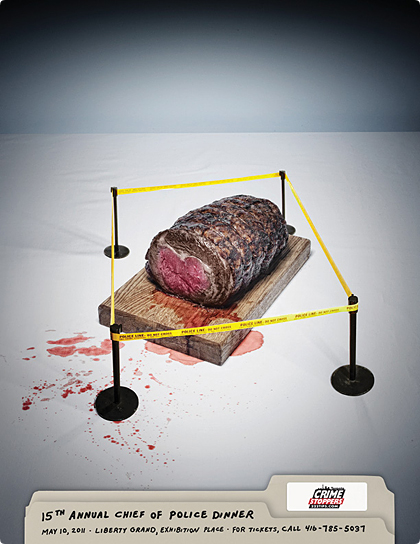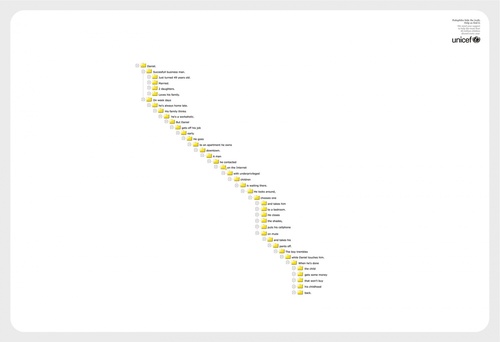-
The following campaigns (one by Unicef and the others by Projeto Arrastào) are very interesting diagrams. I like the way you visually understand the story. I like the variation on the underground maps and the window files arborescence in order to tell a story. The addition of the text and visual is a very interesting thing to work with the pupils, in my opinion. What do you think? What about using this type of detournement?
 your comment
your comment
-

This kind of visual could be the basis for a work on slogans and catchphrases. We could ask the pupils to keep the visual and change the catchphrase for example.
Here for instance we could write : " crime scene - become a vegetarian". What do you think?
 your comment
your comment
-
The series is so funny! It consists in parodies of various films trying to show how they should have ended. It often criticizes them but in the end it is really hilarious!
Really great to study it in class.
Here is the link and then some videos:
 your comment
your comment
-
The series is so funny! It consists in parodies of various films trying to show how they should have ended. It often criticizes them but in the end it is really hilarious!
Really great to study it in class.
Here is the link and then some videos:
 your comment
your comment
-
-
The following advert is for Google's Street View. The concept is that at the top left hand corner it displays an original genuine advert and it suggests that the hotel's ad is here misleading. The Google's ad plays on the decay which exists between the advert and reality.
Possible Xbloggtation: Could be interesting to make pupils react on Google's legitimacy to criticize another advert. Indeed, what if the hotel was really welcoming? What about the persons working hard for this hotel? What could be the consequences of Google advert? Aren't they patronizing?
 your comment
your comment
-
The following advert is for Google's Street View. The concept is that at the top left hand corner it displays an original genuine advert and it suggests that the hotel's ad is here misleading. The Google's ad plays on the decay which exists between the advert and reality.
Possible Xbloggtation: Could be interesting to make pupils react on Google's legitimacy to criticize another advert. Indeed, what if the hotel was really welcoming? What about the persons working hard for this hotel? What could be the consequences of Google advert? Aren't they patronizing?
 your comment
your comment
-
I'd like to congratulate Loïs for the important participation to the blog. I really appreciate. Actually I thank every pupil from Lycée Lacroix ;)
Loïs sent me her work. She was inspired by the Kafa's campaign. I just let you enjoy the really excellent work!
The Kafa's campaign is to be found in the following article: HERE

First picture : Ben
I made this work using Kafa's campaign (against verbal violence) but I did it for Ben and the word "monster", because it's a word people often used to qualify him, and particularly Harriet, from the moment Ben exists, even when he is just a foetus, she considers him as a monster. His father does too, his brothers and sisters, the rest of the family...
So I recorded myself saying this word, and then I played it with media player and chose the visual effect which is showing the sound waves. I made a screen capture of it, and then I used the shape of it to draw a scar on the little boy's face. For the color of the scar I used a picture of a scar founded on the internet.
With this work I wanted to show that to me, it's the fact his family is rejecting him and treating him like a monster which made him violent and different. Because to me, when you are convinced by the other, or even sometimes by yourself that you are something ( a monster, bad in mathematics or whatever) you really become what you're convinced to be at the end. And that explains the slogan "if you say to your child he's a monster he'll probably become one." I'm sorry, the realisation is not perfect from a technical point of view, but I'm not really talented at that.
Second picture : Jane
I just made the same with Jane, with the word "invisible" . I did this because Jane is the one we always forget, we don't know anything about her.
In the passage of the delivery, she is mentionned, and D.L adds to her name "the four year old" and that shows very well the reader doesn't know who she is. And even if her sadness is not mentionned, I'm sure she feels sad and abandonned because her parents are too busy with Paul and Ben to think about her, and she must suffer of it. your comment
your comment
-
Dorothy's dolls.
> This matriochka doll is about the grandmother Dorothy, that's why I chose a smily old woman at first.
> Then, we can see Tinker Bell. I think that Dorothy is like her because it's like she's got a "magical power", when she's here, everything is ok.With the pixie, it's the same
thing, with her wand, she changes all bad situations.The link between the two is that everything became beautiful with them.
> Next, there is Mary Poppins.Poppins is a famous nanny. Her and Dorothy are close because they're human and especially they take care of children and all the house. The
Banks' familly needs Mary's help and because of her, parents will understand that their dream dislocates all the familly.It's the same for the Lovatts. Harriet and David want to
have a big familly but the old woman says to them that it's crazy and they realize it at the end.
> Last, I put Super nanny. She controls every thing, she changes parents and children, she's got a strong personnality and imposes her rules. We can say that Dorothy is
the same basically. Also, she's self-asured and is not afraid about nothing.All the familly loves this incredible woman ! your comment
your comment
-

PAUL
Presentation:
The photomontage is based on the idea of Russian nesting dolls which is a set of dolls.
In this document, there are three different characters, the little boy from Le Petit Nicolas, then a little baby and finally E.T the Extra-Terrestrial.
Description:
The first character that is to say the big one looks like a normal child, and more precisely he looks like an exemplary child. He is wearing a white shirt with a red jumper. Moreover, this little boy is bue-eyed and brown-haired.
Then, the second character is a baby who is crying. He does not wear any clothes.
Finally, we can see E.T the Extra-Terrestrial who looks weak
Analysis:
The first character looks normal and he is like an exemplary child. Actually, he looks like a child who is intelligent. That's why he is like Paul. Indeed, physically the fourth child looks normal, without any problems.
Then, the second character reveals Paul's childhood and in particular when he was baby. Indeed, he was without any attention from his parents. « Paul lay whimpering in his pram, ignored »
Paul has to share his mother with Ben, the fifth child. He is considered as a toy for Ben, he will remain traumatized by Ben. That's why this child represents Paul because he is suffering because of the lack of attention for him.
Finally, the third character shows Paul's inside him. Indeed, because Ben has broken his arm and has traumatized Paul, the fourth child will be infected by Ben even if he looks like a normal child. Indeed, inside him Paul is disturbed by Ben. That's why we can consider Paul as a monster. Indeed, because he was infected by Ben the monster, he is inside him a monster too. However, he is not an evil monster such as Ben, Paul is a kind monster who is misunderstood and who needs help in particular from his parents such as E.T. Paul is a innocent and frail monster.
 your comment
your comment
-

Harriet's Russian doll.
This document is a photomontage, it is like a Russian doll.
First, We can say that Harriet is a strong woman. We studied in the first extract that Harriet's physical appearance is strong, and in the beginning of the book, she wanted to have a big family, a lot of children, a big house, thinking working in the same time. She saw herself as a strong woman, not physically but she thought she had a strong mind. That's why the first picture is a strong woman.
Then it is “Le malade imaginaire” by Molière, because Harriet is always pregnant and says that she is sick, she always needs the help of her mother while her sister, Sarah, needs more help from Dorothy, and Sarah does not complain contrary to Harriet who asks always the support of her mother.
The third doll is a character from a series called Gossip girl. What is interesting here is the word “gossip”, because at a moment Harriet said nasty things about Amy, the children of her sister Sarah, who is a mongol child. I think we can compare her to a gossip girl because she said it to David and Sarah never knew what Harriet said.
We finish with a woman and her baby in her arms, protecting him. Here is an important face of Harriet, and must be the more important. Harriet supports her child Ben till the end of the book whereas the other characters of the family reject him during all the book. Harriet is with Ben like a real mother, she is present for her son, she does what she can for him, for his integration in the society. An important moment is when Ben is in the institute about to die, and Harriet saves him, she plays her mother's role.
To conclude, it is important to emphasize that David rejects completely Ben and doesn't support Harriet in the integration, on the contrary, he rejects Harriet too.
 your comment
your comment
-
The first character is Harriet. She's a dreamy woman, full of ambition.
The second character represents her « old fashion » face. In fact, it seems she's living in a time which is not hers. In the book The Fifth Child , Doris Lessing said that Harriet prefers staying a virgin and waiting for the one she'll love and live with. Harriet doesn't even like this new generation, the seventies. She's not in her world.
The last character is a child. It shows the « young » face of Harriet. Indeed, she's immature, and she's always asking for help to her mother, Dorothy. She's not independent.
 your comment
your comment
A blogstorming experience that will blog your mind

















